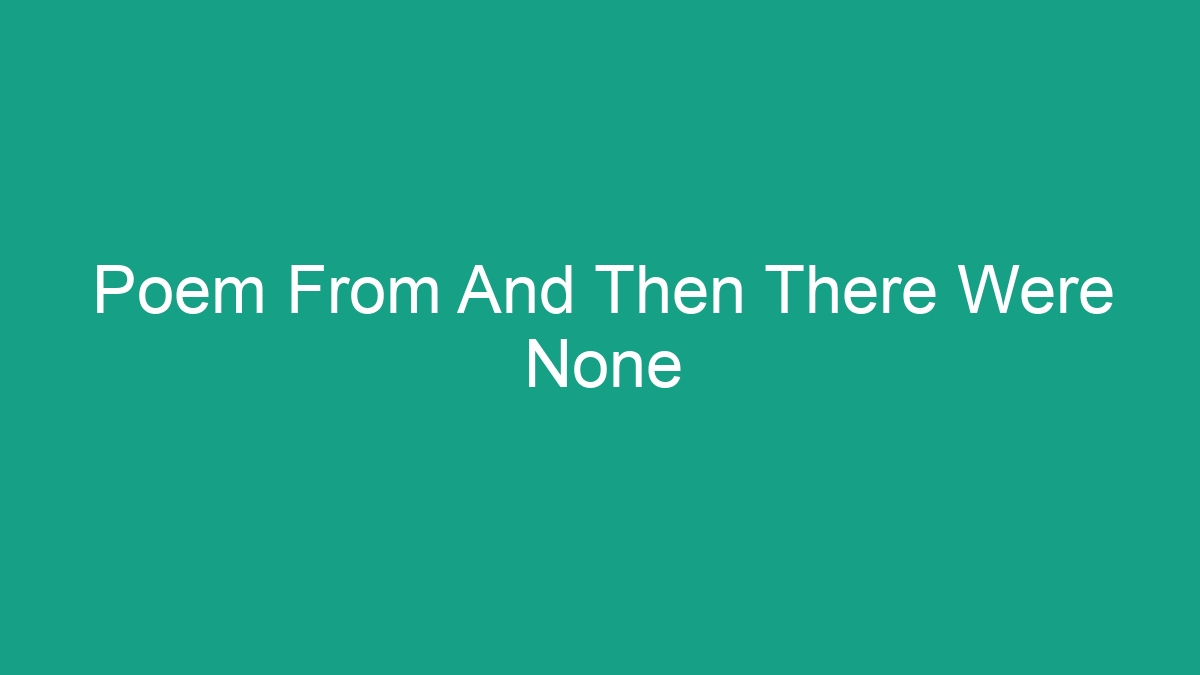
And Then There Were None is a mystery novel by Agatha Christie, published in 1939. The book is widely regarded as one of Christie’s greatest works and is considered a masterpiece of the mystery genre. The poem from And Then There Were None is a key element of the story, providing clues to the unfolding mystery, as well as serving as a haunting narrative device that adds to the overall atmosphere of the novel.
The Importance of the Poem
The poem from And Then There Were None is a nursery rhyme that serves as a central motif in the novel. It is repeatedly referenced by various characters throughout the story, and its significance becomes increasingly apparent as the plot unfolds. The poem sets the tone for the events that are about to unfold and foreshadows the fate of the characters on the isolated island.
The Poem’s Text
The poem from And Then There Were None, also known as “Ten Little Soldiers” or “Ten Little Indians,” is as follows:
| Ten little Soldier Boys went out to dine; |
| One choked his little self and then there were nine. |
| Nine little Soldier Boys sat up very late; |
| One overslept himself and then there were eight. |
| Eight little Soldier Boys travelling in Devon; |
| One said he’d stay there and then there were seven. |
| Seven little Soldier Boys chopping up sticks; |
| One chopped himself in halves and then there were six. |
| Six little Soldier Boys playing with a hive; |
| A bumblebee stung one and then there were five. |
| Five little Soldier Boys going in for law; |
| One got in Chancery and then there were four. |
| Four little Soldier Boys going out to sea; |
| A red herring swallowed one and then there were three. |
| Three little Soldier Boys walking in the zoo; |
| A big bear hugged one and then there were two. |
| Two little Soldier Boys sitting in the sun; |
| One got frizzled up and then there was one. |
| One little Soldier Boy left all alone; |
| He went and hanged himself and then there were none. |
The Poem’s Symbolism
The poem from And Then There Were None is a crucial element of the novel’s plot, embodying themes of fate, retribution, and the inevitability of death. Each of the ten little soldier boys represents a character in the story, and their individual fates mirror the deaths that occur on the isolated island. The poem sets the stage for the unfolding mystery, creating an atmosphere of foreboding and impending doom.
In addition, the poem’s repetitive nature serves to emphasize the cyclical and inescapable nature of the characters’ fates. As each little soldier boy meets their demise, the countdown continues until there are none left. This relentless progression reinforces the sense of inevitability and fatalism that permeates the novel, heightening the tension and suspense for the reader.
The Poem’s Connection to the Plot
The poem from And Then There Were None is intricately woven into the fabric of the novel’s plot, serving as a guiding narrative thread that leads the characters and the reader through the unfolding mystery. As the characters on the island begin to realize the connection between the deaths occurring around them and the verses of the poem, the tension and sense of impending danger are heightened.
The poem’s significance becomes even more pronounced as the characters themselves begin to embody the fates of the little soldier boys. With each death that occurs, the remaining characters are forced to confront the grim reality that they may be the next to meet their end, creating a sense of paranoia and suspicion that drives the plot forward.
Interpretations and Adaptations
Throughout the years, the poem from And Then There Were None has been the subject of various interpretations and adaptations, further solidifying its status as a captivating and enduring literary motif. In addition to being featured in stage and screen adaptations of the novel, the poem has been the inspiration for music, art, and further literary exploration.
- Stage and Screen: The poem’s eerie and evocative nature has made it a fitting addition to stage and screen adaptations of And Then There Were None. Its haunting verses serve to heighten the atmosphere in these visual mediums, adding an extra layer of dramatic tension to the unfolding mystery.
- Music: Musicians and composers have been inspired by the poem’s ominous themes, incorporating its verses into their works. From orchestral compositions to popular music, the poem has been reimagined in various musical forms, showcasing its enduring impact and cultural significance.
- Art and Literature: The poem has also been the subject of artistic interpretation and reimagining in various forms of visual and literary art. Its haunting imagery and symbolic resonance have provided inspiration for artists and writers, leading to diverse and thought-provoking creations that continue to explore its timeless themes.
Conclusion
The poem from And Then There Were None is a central and crucial element of Agatha Christie’s timeless mystery novel, serving as a haunting and evocative narrative device that adds depth and resonance to the story. Its symbolic significance, interconnectedness with the plot, and enduring impact have solidified its status as a literary motif of great cultural and artistic significance.
As readers continue to uncover the mysteries of And Then There Were None, the poem remains a key component of the novel’s lasting legacy, captivating and haunting audiences with its timeless themes and enduring relevance.




